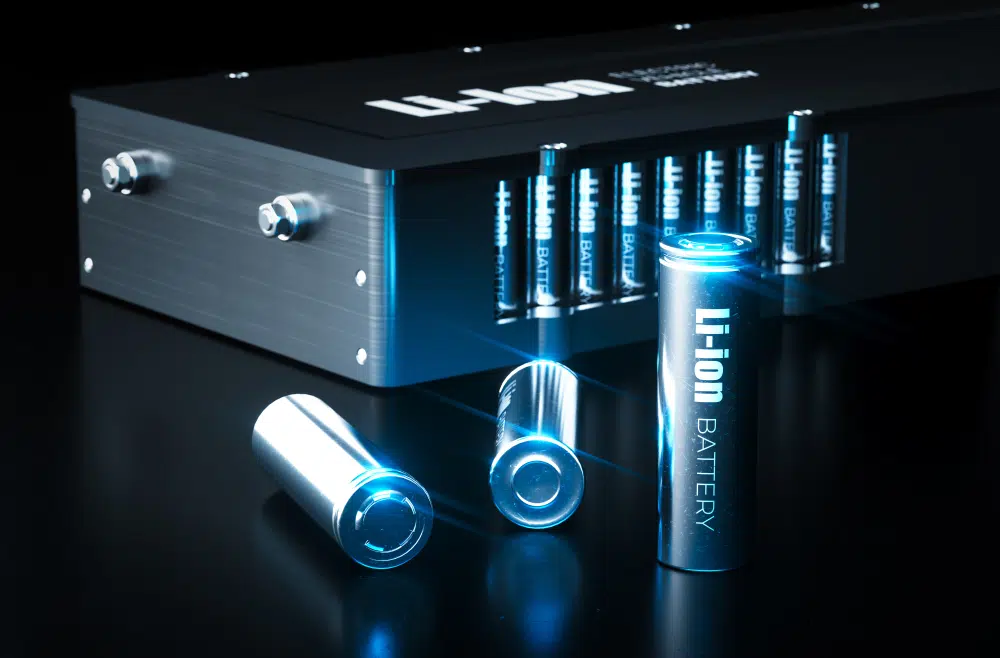Co-Authored by: Dr. Azita Soleymani and William Maltz
The global shift to electric vehicles (EV) is coming and, unless an alternative technology emerges, it will be fueled by high-capacity lithium-ion (li-ion) batteries. Making the hundreds of millions of li-ion batteries the world will eventually need for e-mobility is a massive undertaking full of technical challenges. Concerns about battery pack size, weight, cost and sustainability have to be resolved before there can be a mass rollout of “green” cars. Some of the issues that will be affected by the thermal environment include battery life span and safety. Another benefit, that can result from regulating cell and battery pack temperature within a given range, include an increase in the number of cycles a battery can achieve, making performance more dependable. More importantly, an effective thermal solution reduces the probability of catastrophic battery failure.
Unlike most electronic integrated circuits and microchips in electric vehicles, which operate best at -40˚C to 85˚C or higher, the optimal temperature range for li-ion battery packs is quite narrow and varies depending upon cell supplier, charge and discharge mode and other factors. Both low temperature and high temperature that are outside of this region will lead to degraded performance and irreversible damages, such as lithium plating and thermal runaway.
The thermal requirements of battery packs are specific. Not only the temperatures of the battery cells are important but also the uniformity of the temperature inside the battery cell and within the battery pack are key factors of consideration, in order to deliver a robust and reliable thermal solution. Less temperature uniformity results in the rapid decay of the cycle life of the battery pack. Even worse, a non uniform temperature distribution may aggravate the unbalanced discharging phenomenon and decrease the available energy for the battery packs.
To evaluate the thermal management system of a li-ion battery pack, the design of experiments (DOE) has to incorporate a range of conditions to ensure that all thermal requirements are met: fast charging, cold start, charging at low temperature, discharging when the charge was low and different drive cycles [1].
Numerical simulation is a powerful tool for evaluating and optimizing a thermal solution at the early stage of design and development [2]. Later, it is used to conduct trouble-shooting. Among the most commonly applied modeling approaches, the electrochemical model provides high accuracy in estimation since it originates from the first principles of underlying electrochemistry. However, accurate estimation is achieved at the cost of high computational power. This makes the method impractical in real-time applications in the battery packs.
In contrast, the equivalent circuit model (ECM) is widely accepted at the application level because of its simplicity and ease in online implementation [3]. ECM utilizes system identification techniques to relate the input and output behaviors of a battery cell with circuit elements. All parameters in the ECM are multi-variable functions of State of Charge (SOC), current, temperature, and cycle number. The ECM representation of a battery cell can be used to estimate real-time heat generation and current-voltage (I-V) performance of the battery cell at different operational conditions if the model parameters are well defined [4]. The ECM representation of a battery cell can be integrated within network models of the battery pack to estimate the real-time bulk temperature of cells during different operating scenarios [5]. A network model of the battery pack represents a full battery pack, which includes cells, tabs, electronic connectors, and cooling systems [6]. Such models are typically not sufficiently accurate for thermal analysis and they are primarily used by electrical engineers as part of their electric circuit model.
This article describes a semi-analytical digital twin model of a 90 kW.h li-ion battery pack. The model is used to capture the thermal behavior of the pack in a real-time environment. The paper will demonstrate how the digital twin models of battery packs can be used to perform what-if scenarios, to conduct in depth root cause analyses, to further optimize the cooling system, to make battery pack life-time predictions and to optimize operating parameters for thermal management. To the knowledge of the authors, this is the first study that utilizes a digital twin model to predict the real time thermal behavior of a full battery pack with high energy capacity of 90 kW.h. The model validation was achieved by comparison of the Digital Twin model results against experimental data over a few dynamic driving profiles.
REAL-TIME HEAT GENERATION RATE
Generation of the digital twin model requires estimation of the real-time heat generation in the battery pack. There are three main sources of heat generation in a battery pack, namely ohmic, kinetic and entropic heat. Ohmic heat comprises transport in the wires and connectors, as well as within the battery. Kinetic and entropic heat are due to electrochemical reactions. While kinetic heat is due to reaction at the electrode-electrolyte interface and is therefore always exothermic, entropic heat is due to thermodynamic considerations of the electrochemical reaction and can be exothermic or endothermic.
The heat generation rate in a li-ion battery cell varies as a function the of SOC, temperature and the charge/discharge rate profile. Typically, the heat generated by the li-ion battery cell is estimated from isothermal battery calorimeter testing [7], detailed multi-physics computational fluid dynamics simulations, or ECM approaches. The calorimeter testing is limited to the operational conditions such as SOC, electric current and temperature for which the measurements were carried out. Considering the costs involved and the total number of cases to be measured, calorimeter testing is not feasible for estimating the heat generation rates for a wide range of conditions applicable to the battery packs in EV cars.
The ECM model can meet the real-time implementation requirements; hence it is well suited for Electric Vehicle battery thermal management studies. Figure 1 illustrates the ECM representation [4] of the lithium-ion batteries used in this study. The two RC networks can be interpreted as a combination of fast and slow time-domain characteristics of the chemical reaction within the battery cell.

OCV represents the open circuit voltage of the cell. R0 is the instantaneous response due to the ohmic effect in the battery cell. R1 and R2 are the charge transfer resistance and diffusion resistance, respectively.
To obtain the parameters of the 2RC model, Hybrid Pulse Power Characterization (HPPC) experiments were conducted. In order to consider the temperature effect on the cell parameters, HPPC tests were conducted at ten different temperatures (from -20˚C to 60˚C). All parameters were calculated based on these temperatures and at different SOC levels (5% to 100%) and different pulse durations (1 to 30 seconds) for several charging and discharging cycles (c-rate from 0.3 to 6). An algorithm based on the Recursive Least Squares method was developed to calculate the 2RC model parameters from the HPPC test results.
The results of the ECM provide valuable information about cell heat generation rate, terminal voltages, and SOC in real-time, even if the physical sensors embedded inside the battery pack become faulty and or fail for any reason.
To validate the resulted ECM model, a li-ion battery cell was placed in a thermal chamber. The cell was connected to an Arbin battery testing system. This allowed complex real-world EV drive and charge profiles to be precisely replicated and measured. The terminal voltages of the battery cell at different profiles were recorded and the results were compared to the ECM model results at the same operating conditions. Good agreement was observed between the model results and the test data over a wide range of operational conditions. The comparison of the model results against the test data for the US06 drive cycle at 25˚C is depicted in Fig. 2. The model predicts the voltage response with an accuracy that is within 25 mV.
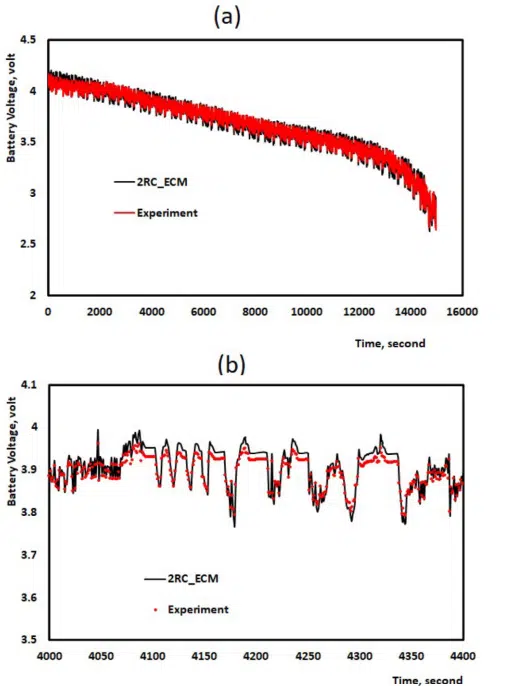
The real time estimation of a single cell heat generation rate at three different temperatures for US06 drive profile is shown in Fig. 3. The cell is initially set at 90% SOC and the discharge continues until the SOC reaches 5%. The time required to reach 5% SOC decreases as the temperature decreases. This can be attributed to the fact that the full capacity of a given cell drops with a decrease in temperature. For all three temperatures, an abrupt increase in the heat generation rate toward the end is pronounced. This can be explained by the sudden increase of the internal resistances of the cell at 20% SOCs.
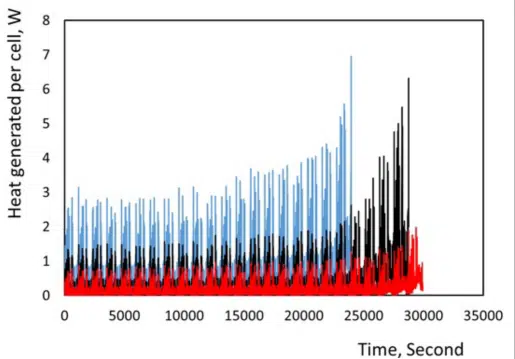
DIGITAL TWIN ENABLES REAL-TIME ANALYSES
The methodology used in the present work is shown in Fig. 4. A set of transient high-fidelity 3D simulations were performed to generate response curves at the battery pack level. The response curves were then fed into the reduced-order model (ROM) application of commercially available software [8] to create the ROM of the battery pack. Linking the ROM and ECM of the battery cell in a Twin Builder produced a digital twin model of the battery.
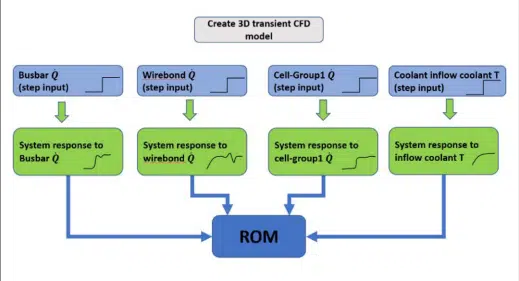
The temperature results from the developed digital twin model of the battery pack were compared to the data obtained from the experiments to validate the digital twin model. Figure 5(a) shows the temperature change of the battery pack initially at 90% SOC and 25˚C as the battery pack was discharged at a constant c-rate of 1.5 for 1800 seconds. Fig. 5(b) presents the change in the temperature of a 10% SOC battery pack charging for 3000 seconds. As shown in Fig. 5, there is excellent agreement between the results obtained from the digital twin model and the experimental results. A maximum difference of 0.7˚C was observed between the digital twin model and the experimental data.
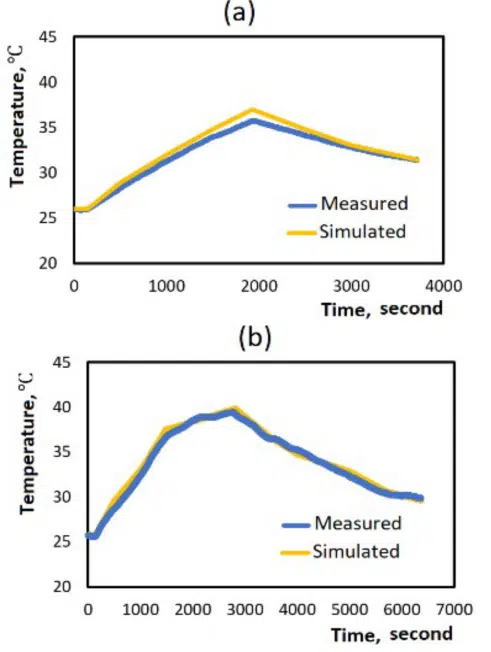
The validated digital twin model of the full battery pack was used to evaluate the critical design elements required for an effective thermal monitoring system and significantly reduce the calculation time from weeks to hours, as compared to other approaches. The generated model can be used by non-simulation experts to explore different operating conditions and perform real-time monitoring or predictive maintenance.
APPLICATIONS OF DEVELOPED DIGITAL TWIN
Evaluate the design feasibility of a thermal solution for the battery pack- The generated digital twin model was used to accelerate battery pack design and development by enabling engineers to evaluate design feasibility and to conduct in-depth root cause analyses for various inputs and operating conditions, including initial SOC, temperature, coolant flow rate, different charge and discharge profiles. Every battery pack thermal management design can be evaluated for a wide range of conditions including fast charging, cold start, charging at low temperatures, discharging at different drive cycles. For each scenario, all of the thermal requirements were monitored.
Perform trouble shooting- Live sensor data was integrated into the digital twin system-level model of the battery pack to create a real-time environment. The generated tool was utilized in the prototype. It was used in validation testing to remotely monitor the real-time temperature of the battery pack and to troubleshoot the test set up. The model acted as a virtual sensor for controllers in which it is hard or impossible to install a sensor.
Position the temperature sensors- The model provided great insight into the temperature profile within the pack at different operating conditions. The results were used to guide the placement of physical monitoring systems.
Optimize the cooling system operating parameters- The generated digital twin model of the battery pack was integrated into a full system level model of the vehicle cooling loops. The resulting model was used to optimize the operating parameters of the cooling loops, as there is a tradeoff between passenger comfort and the battery pack’s aging.
Estimate battery pack lifetime- The results of the generated digital model, in conjunction with the empirical models correlating the cell degradation with temperature, were used to estimate the aging of battery packs at different ranges of long-term operating conditions.
The semi-analytical digital twin model operating in real-time was used to perform what-if scenarios, to conduct in-depth root cause analyses and to estimate the lifetime of the battery pack. Further, the model was used to develop and optimize the operating setup of the vehicle cooling loops for user comfort and safety. The reliability and the low computational cost of the developed model significantly reduced the time required for optimizing and troubleshooting the battery pack thermal system. This also resulted in a significant reduction in the time-to-market.
References
[1] Yang X-G., Zhang G., Ge S., Wang C-Y., Fast charging of lithium-ion batteries at all temperatures. =Proceedings of the National Academy of Sciences. 115(2018) 7266-7271.
[2] D. Ghosh, Maguire, and D. X. Zhu, Design and CFD Simulation of a Battery Module for a Hybrid Electric Vehicle Battery Pack, SAE paper 2009-01-1386.
[3] Hu, X., Lin, S., Stanton, S., and Lian, W., A State Space Thermal Model for HEV/EV Battery Modeling, SAE Technical Paper 2011-01-1364.
[4] Rahmoun, Ahmad & Biechl, Helmuth, Modelling of Li-ion batteries using equivalent circuit diagrams. Przeglad Elektrotechniczny. 88(2012) 152-156.
[5] Yen, C., Han, T., Kaushik, S., and Khalighi, B., Application of CAEBAT System Approach for a Liquid Cooled Automotive Battery Pack, SAE Technical Paper 2016, 01-1205
[6] L. Gao, S. Liu, and R. A. Dougal, Dynamic Lithium-Ion Battery Model for System simulation, IEEE Trans. Comp. Package. Technology, vol. 25, No 3 (2002) 495-505.
[7] Pesaran, A. Battery Thermal Management in EVs and HEVs: Issues and Solutions. Battery Man. 43(2001).
[8] Ansys DesignXplorer’s 3D ROM builder, www.ansys.com
About the Authors

Dr. Azita Soleymani is a director at Electronic Cooling Solutions Inc. (ECS) and has over 15 years of experience in thermal management. Azita received her PhD in Mechanical engineering at Lappeenranta University of Technology in Finland. She is the co-author to over 30 technical papers. Her expertise includes thermal design of power electronics, consumer electronic products, data center, medical and automotive equipment.
Prior to joining ECS, Dr. Soleymani was thermal-mechanical manager at Byton Inc. where she had the opportunity to develop a thermal solution for Li-ion battery pack in electric cars.

William Maltz is the president and founder of Electronic Cooling Solutions Inc. (ECS) and has over 35 years of experience working on and solving thermal management problems for electronics companies. During his 28 years of consulting, Mr. Maltz has provided thermal management expertise to companies that include: Amazon, AMD, Apple, Boeing, Brocade Communications, any many more.
He has shared technical sessions for Semi-Therm, the Semi-Thermal Thermal Technologies Workshop, ASME InterPACK Conference and the I-Therm Conference. He is also an active member of the Silicon Valley Chapter of the ASME, Semiconductor Thermal Measurement, Modeling, and Management Symposium (Semi-Therm), as well as the program committee for the Semi-Therm Thermal Technologies Workshop.
Mr. Maltz received his Bachelors of Science Degree in Mechanical Engineering from San Jose State University
